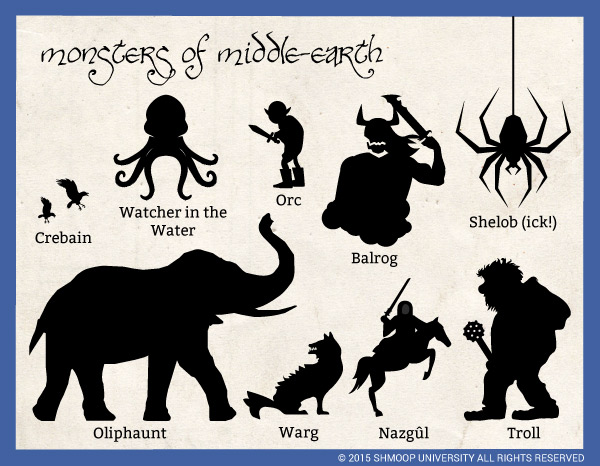Character Analysis

(Click the character infographic to download.)
Note: Before we jump into discussing Gandalf in The Two Towers, you might want to take a peek at Gandalf's "Character Analysis" for The Fellowship of the Ring for some background.
Gandalf the wizard is, let's face it, a bit of a drama queen in The Two Towers. Oh, we get it: it's probably stressful to be pulled down into the depths of Moria by a demon of the old times, to fight for your life without any real expectation of survival. But when Gandalf returns (apparently) from the dead and appears in front of Aragorn, Gimli, and Legolas, he practically blinds them with the light beaming out of his face and white robes. Clearly, he has decided to stop hiding his overall awesomeness from the world.
See, in The Hobbit and in The Fellowship of the Ring, we know that Gandalf is really smart and powerful. But we also see him make mistakes. He misjudges Saruman and he falls (supposedly) to his death in Moria. In The Two Towers, once Gandalf has gone through his whole struggle with the Balrog in Moria, we start to see how truly powerful he is. Time and space don't seem to matter for Gandalf the same way they do for us ordinary mortals. He can fall for days and still come up swinging when he hits the ground. Gandalf the Grey may have been pretty tough, but The Two Towers' new, improved Gandalf the White puts the power in superpower.
Gandalf the… Angel?
Gandalf's huge grey beard and pointy hat may not fit in with our usual mental images of angels (though Gandalf does rock a white robe). Even so, in Tolkien's letters in which he mentions Gandalf, it turns out that Tolkien thinks of Gandalf that way—as Middle-earth's version of an "incarnate angel" (source, pg. 202). "Incarnate" means that Gandalf has a physical body, and "angel," of course, means that he's a representative of the forces of Good.
Both of these aspects of Gandalf—that he has a physical body, which means he has limits, and that he's an angel, which means that he's Good—come out in full force in The Two Towers.
First, the "incarnate" part: Gandalf really believes that he's going to die in Moria. When he doesn't die, well, that's a big ol' bonus for the Good side. But the fact that Gandalf was willing to make that sacrifice, even with his great power and potential to do Good in the War of the Rings, proves that he's, at the end of the day, a humble guy. Let's take a peek at Tolkien's description of Gandalf's death and resurrection, included in one of his famous letters:
For in [Gandalf's incarnate] condition it was for him a sacrifice to perish on the Bridge in defence of his companions, less perhaps than for a mortal Man or Hobbit, since he had a far greater inner power than they; but also more, since it was a humbling and abnegation of himself in conformity to 'the Rules': for all he could know at that moment he was the only person who could direct the resistance of Sauron successfully, and all his mission was vain. He was handing over to the Authority that ordained the Rules, and giving up personal hope of success. (Source, pg. 202.)
In other words, like Frodo, Gandalf is willing to die if it is his time. He'll fight against the Balrog, but he won't fight against his Fate or the larger Plan of the forces of Good. Gandalf recognizes his limits, which is what makes him different from his hugely ambitious enemies, Saruman and Sauron.

(Click the infographic to download.)
Now let's tackle the "angel" part. We know that Gandalf is a force for Good. From his first appearance in The Hobbit, when we find out that Gandalf has been fighting the Necromancer (Tolkien's early name for Sauron), we've seen that Gandalf is a powerful force against evil. As Sauron gets stronger, Gandalf becomes more and more openly angelic in order to face him down.
It's significant that he becomes Gandalf the White just as the Fellowship breaks up and Aragorn starts planning to join the Gondorians and make open war against Mordor. As the books go on, Gandalf becomes less and less human and more and more a pure symbol of wisdom and good counsel (which, honestly, makes him a little less relatable to us sometimes. He's a lot funnier in The Hobbit. Hey, we're just saying… ). But the more symbolic he gets, the more the other forces for Good can trust his motives and rely on him. They know he won't lead them astray.
One last thing about Angel Gandalf: he's not just angelic because he's a good person and he wears white. He's also an angel because he inspires the other characters to be better versions of themselves. When Frodo feels briefly tempted to kill Gollum, he remembers Gandalf's advice to be merciful and decides not to do it. When Théoden gets possessed by Saruman's evil spells (through the oh-so-icky Gríma Wormtongue), Gandalf is the one who exorcizes him. Gandalf encourages Aragorn to lead and saves Pippin from the palantír and breaks Saruman's power after the fall of Isengard. Phew. That's a lot of do-gooding. It's lucky for the powers of Good that they've got someone like Gandalf on their side.
Timeline